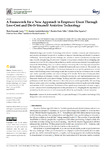A Framework for a New Approach to Empower Users Through Low-Cost and Do-It-Yourself Assistive Technology

Ver/
Use este enlace para citar
http://hdl.handle.net/2183/27686
A non ser que se indique outra cousa, a licenza do ítem descríbese como Creative Commons Attribution 4.0 International License (CC-BY 4.0)
Coleccións
- Investigación (FCS) [1293]
Metadatos
Mostrar o rexistro completo do ítemTítulo
A Framework for a New Approach to Empower Users Through Low-Cost and Do-It-Yourself Assistive TechnologyAutor(es)
Data
2021-03-16Cita bibliográfica
Pousada García T, Garabal-Barbeira J, Porto Trillo P, Vilar Figueira O, Novo Díaz C, Pereira Loureiro J. A Framework for a New Approach to Empower Users Through Low-Cost and Do-It-Yourself Assistive Technology. Int J Environ Res Public Health. 2021 Mar 16;18(6):3039.
Resumo
[Abstract]
Background: Assistive Technology (AT) refers to “assistive products and related systems and services developed for people to maintain or improve functioning and thereby to promote well-being”. Improving the process of design and creation of assistive products is an important step towards strengthening AT provision. Purpose: (1) to present a framework for designing and creating Low-Cost AT; (2) to display the preliminary results and evidence derived from applying the framework. Methodology: First, an evidence-based process was applied to develop and conceptualize the framework. Then, a pilot project to validate the framework was carried out. The sample was formed by 11 people with disabilities. The measure instruments were specific questionnaire, several forms of the Matching Person-Technology model, the Psychosocial Impact of Assistive Device Scale, and a tool to assess the usability and universal design of AT. Results: The framework integrates three phases: Identification (Design), Creation (Making the prototype), and Implementation (Outcome Measures), based on the principles of Design Thinking, and with a user-centered perspective. The preliminary results showed the coherence of the entire process and its applicability. The matching between person and device was high, representing the importance of involving the user in the design and selection of AT. Conclusions: The framework is a guide for professionals and users to apply a Low-Cost and Do-It-Yourself perspective to the provision of AT. It highlights the importance of monitoring the entire procedure and measuring the effects, by applying the outcome measures.
Palabras chave
Framework
Do-it-yourself (DIY)
Occupational therapy (OT)
Assistive technology (AT)
Design
Low-cost
Outcome measures
Do-it-yourself (DIY)
Occupational therapy (OT)
Assistive technology (AT)
Design
Low-cost
Outcome measures
Versión do editor
Dereitos
Creative Commons Attribution 4.0 International License (CC-BY 4.0)
ISSN
1660-4601






